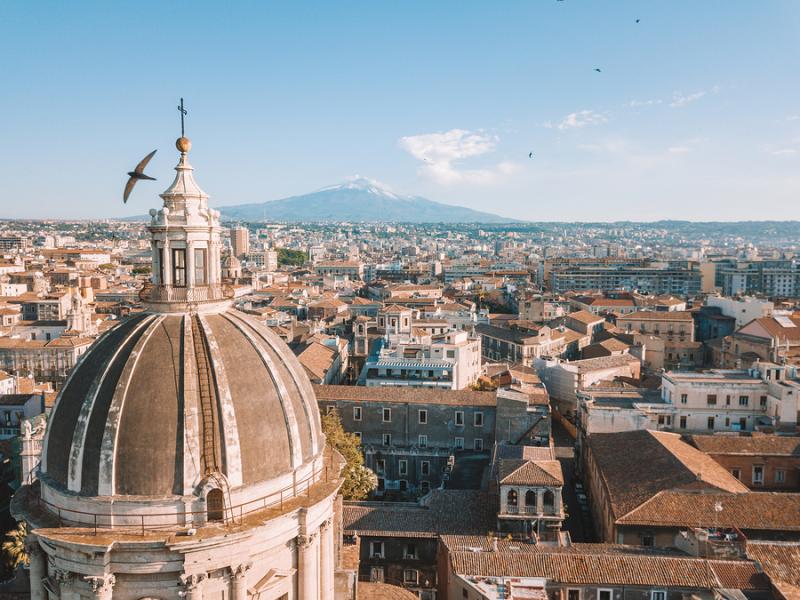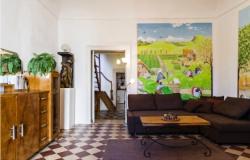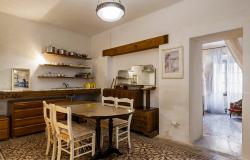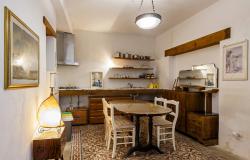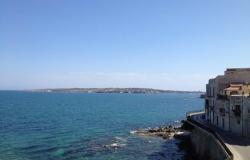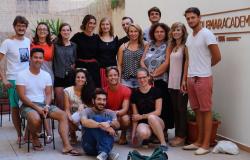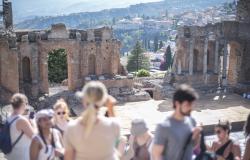Catania is one of the most picturesque cities in Sicily, its landscape is dominated by the volcanic giant of the Mount Etna volcano which gives the city its suggestive lava rock palate.
Sicily’s second-biggest regional capital is a vital part of the transport network in the Mediterranean, a major port of call for export and an international airport which makes it easy to excess and allows it to be the focal point for trade expos and essential events.
But Catania is not only about business suits and briefcases, it is made up of a great mixture of fascinating culture, history and traditions to experience on every visit to the city.
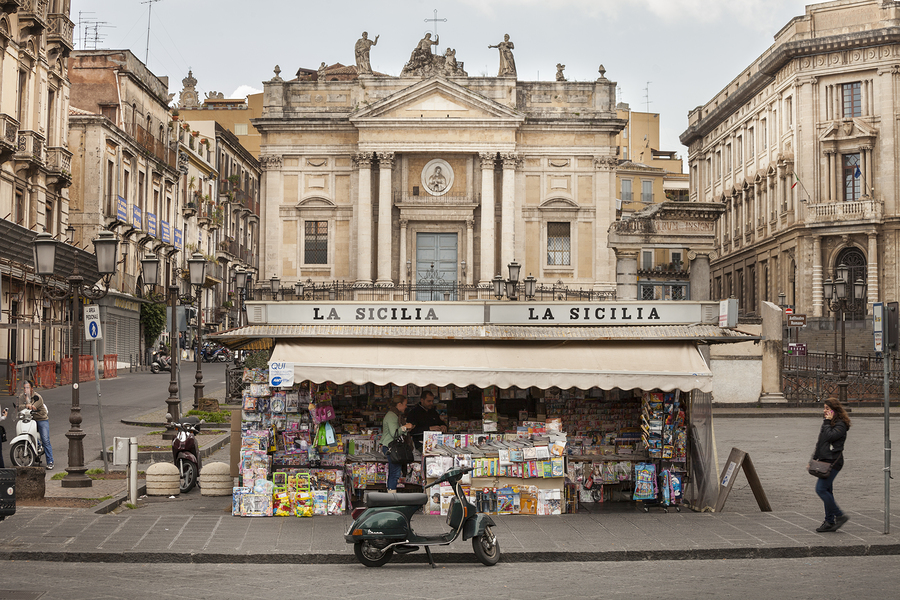
The affectionately named Mamma Etna is seen by locals as both a blessing and a curse, its a symbol of fertility despite having destroyed the city several times during history, but it has also given Catania the opportunity to rebuild itself in its own opulent Sicilian baroque style. The fertile landscape created by this active volcano has produced an abundance of agriculture, a beautiful national park just outside of the city, some of the best wines in the world and a mouthwatering cuisine drenched with fantastic flavour.
While it would take many lifetimes to experience all the beauty that Catania has to offer here are 29 things you just must not miss.
What to do and see in Catania
1) Saint Agatha: The beloved patroness of Catania is celebrated in one of the most elaborate and popular religious festivals in the world, the city comes alive with the local’s faith, suggestive processions, fireworks, decorative lights which spread out through the streets, markets and other events all around the city.
If you want to see the traditional heart of the city visit in early February (from the 3rd to the 5th) where you will witness the dedication the Catanese have to this early young Christian martyr born in Sicily and who has saved the city from everything including the plague and volcanic eruptions.
The statue of Sant'Agata is also taken out in a procession on the 17th of August in honour of the day when her relics were returned to the city after being taken to Constantinople, so if you don’t fancy a winter visit, you can witness similar festivities in the summer.
2) Saint Agatha churches: If you want to avoid the crowds and confusion, you can always visit the principal sites associated with Sant Agata at any time of the year and literally follow in her footsteps by attending the churches dedicated to her. The main cathedral of Sant’Agata displays the elaborate decorative gold bust and reliques of the Saint which feature at the centre of the main celebrations. While the Church of the Badia di Sant’Agata will give you the best views of the city from its impressive ornamental dome and the Church of Sant'Agata al Carcere is built upon the original prison cell where Agata was imprisoned.
3) There are many examples of exquisite ecclesiastical works of arts and objects in a separate museum a few steps from the Cathedral. The Museo Diocesano di Catania right on the same square as the Duomo holds many precious church items associated with the cult of Saint Agata. The terraces of the museum offer a magnificent view of the main street of the city, looking out towards Mount Etna directly over the via Etnea and Porta Uzeda, a beautiful city entrance door built in 1695 after a major earthquake in 1693 which destroyed many towns and cities in southeastern Sicily.
4) As is so common in Italy, there is an astounding amount of layering of different parts of history. It was the seventeenth-century earthquake which allowed the Le Terme Achilliane (Baths of Achilliane) to resurface, they are one of the most important remaining structures from the Roman Empire in Catania. The extensive series of subterranean Roman thermal baths were discovered under the Cathedral, Seminary (the actual site of the Museo Diocesano) and under the Palazzo Sentorio (the Town Hall) all in the heart of Catania’s historical centre.
5) The other precious piece of ancient Roman Catania is the Teatro Romano, an open-air amphitheatre. Dating from three hundred B.C the theatre is exceptionally well preserved in the classical style, it had a capacity for 7,000 spectators complete with an orchestra pit. Today the Teatro is partly submerged with water from the Amenano river, which was covered by a volcanic the eruption of 1669. During Roman times the underground water source served as a water feature for the amphitheatre and was used to move elaborate sets and other equipment needed by the theatre.
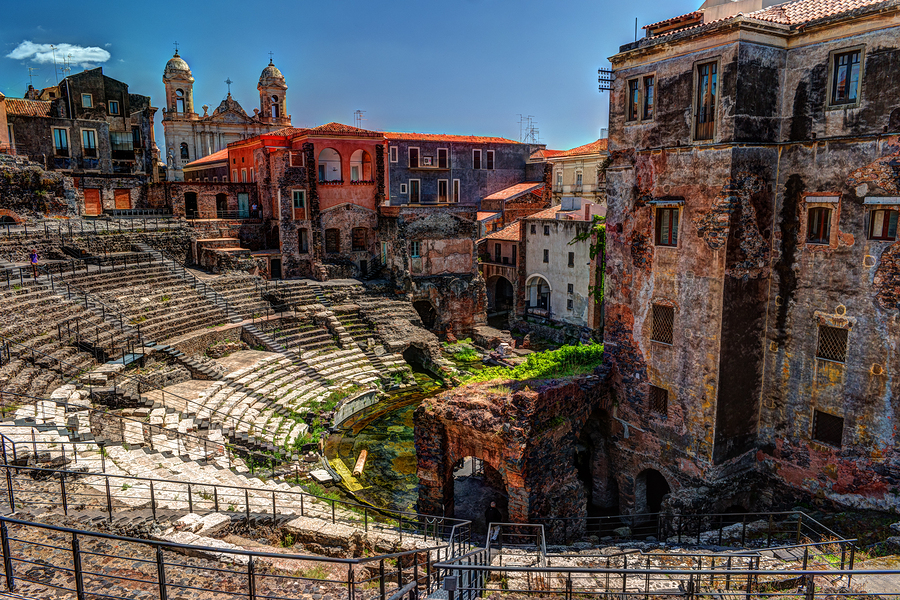
On the western side, there is the Odeon, a smaller theatre also from the Roman period which was believed to be used as a rehearsal space for the main theatre.
6) Teatro Massimo Bellini is an opulent Baroque theatre dedicated to the Catanese opera composer Vincenzo Bellini, and it is one of the most beautiful pieces of architecture to witness in a city made up of one treasure after another. The theatre is open for public tours and has a vibrant calendar of events throughout the year featuring everything from ballet, classical music, theatre to opera. The unique outdoor summer performances hosted by the Teatro in the Piazza Vincenzo Bellini directly in front of the theatre makes the most of the cool summer nights and the stunning backdrop of the beautiful square and fountain.
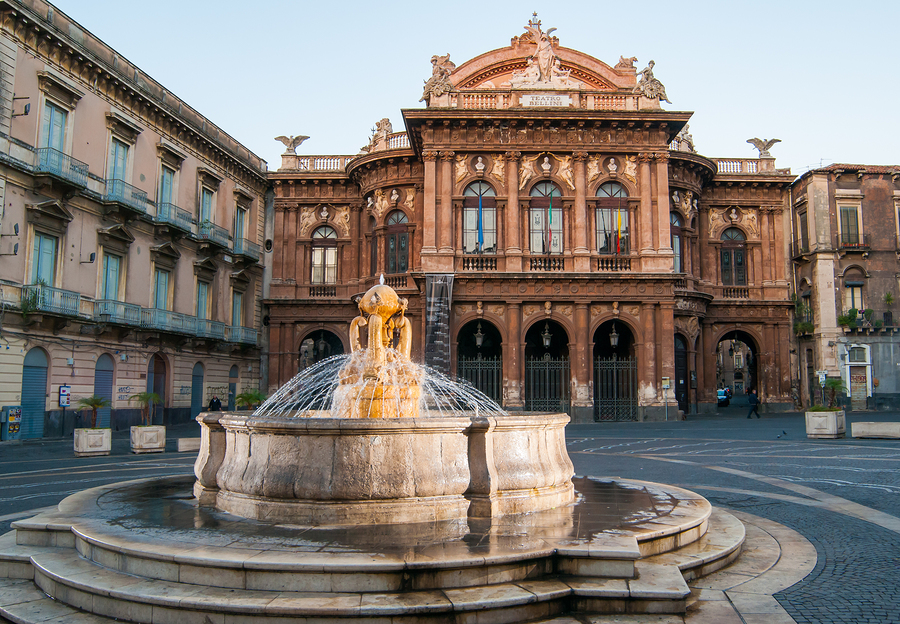
Like this article? Don't miss "29 Things You Must Do In Naples."
7) For lovers of theatre, the Teatro Stabile Catania is a vibrant part of Catania’s cultural life, since 1969 it has been performing in the modern Teatro Verga, a converted cinema at number 39 via Giuseppe Fava. Throughout the year it hosts a mixture of contemporary Italian theatre, classical performances, international theatre, with the most well known Sicilian actors and a focus on Sicilian playwrights such as twentieth-century Nobel Luigi Pirandello.
8) Castello Ursino is a medieval castle left behind by the Normans, French crusading knights who ruled over Sicily in the 13th century and is a most outstanding place to visit. There aren’t many remaining examples of buildings from the Norman period of the middle ages, and so this domineering structure right in the centre of Catania is astounding to witness. It is open to the public for daily tours and also has become a Museum with an impressive archaeological collection.
9) Directly in front of the main Cathedral is the Fontana dell’Elefante in the Piazza Duomo square which is a Roman statue of an elephant carved from basalt, considered to be the symbol of the city. The Elephant itself is quite mysterious as no one really knows why, when and how it became the symbol of Catania, some say the elephant is known as u Liotru is a reference to Hannibal the Great, others refer to a famous local nobleman’s confrontation with a local bishop. During the 9th through 11th-century Muslim rule of Sicily, Catania was already known in Arabic as Madinat al-fīl or the City of the Elephant.

The piazza today is the social heart of the city, a meeting place for locals filled with stores, bars and restaurants surrounded by the most important buildings, palaces, churches and the town hall of the city. So a walk around the piazza and a friendly wave to the Liotru is obligatory for any visit to Catania.
10) The Università degli Studi di Catania is the oldest university in Sicily and was founded by King Alfonso V of Aragon (who was also King Alfonso I of Sicily) in 1434. The university quarter is a vibrant part of the city filled with bookstores, cafes, restaurants and the historical palaces that make up the university are generally open to the public.
Ten minutes walk from the Cathedral is the monastery of San Nicolò l’Arena, a jewel of the late Sicilian Baroque style, it is one of the most massive Benedictine buildings in Europe.
Constructed in the 1500’s the building is a UNESCO World Heritage Site and is home to the DiSUM (Department of Humanities) of the University of Catania, inside it holds a Roman Domus, cloisters and a beautiful roof garden.
11) Palazzo Biscari is the most important palace in the city and represents, the most extraordinary example of Catanese baroque architecture.
The building was rebuilt after the earthquake around 1700 by Ignazio Paternò Castello III, the fifth Prince of Biscari who was a scholar, archaeologist and art lover, who set up the first major museum in Catania to be open to the public. The interior décor is in rococo style with spectacular decorations, stylish furniture, crystal chandeliers which make it feel like the Palace of Versailles.
12) The Benedictine Monastery complex is located in the centre of the city and is one of the most critical and most significant examples of its kind in Europe.
Listed as a UNESCO World Heritage Site, this monastery is a stunning piece of architecture and built initially in 1558. As an amalgamation of many styles, the complex is a series of structures including a Marble Cloister, the Red Hall and the Basilica of Saint Nicolò.
It is a symbol of Baroque Catania, highlighted by an elaborate arc which opens onto via Crociferi. It is said that it was built in just one night and it connects the magnificent abbey, which includes the Church of San Benedetto, the pearl of Catanese baroque architecture, to the small monastery. The convent is the home of the MACS – the Museum of Contemporary Art in Sicily, yet another excellent example of how the city manages to combine its history with modern functionality and art.
13) Boutique hotels: Catania has been enjoying a kind of Renaissance over the past decade with the restoration of many old palazzi in its historic centre and surrounding areas which have seen many boutique hotels popping up in and around the city. So if you are after a romantic getaway for a weekend, why not consider coming to this beautiful baroque city for an exclusive luxury treat.
14) Kiosks: Catania is perfect to explore by foot, you can smoothly go from palaces to churches, archaeological sites, to restaurants, squares to admire the wealth of architecture and chaotic nature of this energetic city. Don’t forget to take short breaks I between the sights to refresh yourself. Keep your sugar levels up with a Sicilian sweet and an espresso at a local bar. Stop also at the decorative Kiosks dotted around each piazza and side street which where the locals grab a quick coffee or snack during the day. Be sure to grab a freshly squeezed blood orange juice (spremuta d'arancia rossa) or a refreshing lemon granita all made with locally grown citrus.
15) Markets: A visit to any major Italian city would never be complete without a trip to the local open-air markets. Catania is famous for its daily traditional fish markets la Pescherie behind the Piazza Duomo which is filled with the sights, sounds smell and tastes of a vibrant tradition. See the local fishermen sell their catches and then easily find a nearby restaurant which will prepare it all for you in the freshest seafood meal you’ve ever eaten.
The daily markets of the Fera o’luni, are held daily in Piazza Carlo Alberto and offers everything from street food, local crafts, antiques and fresh fruit and vegetables.

16) Shopping: the potential stops to pursue a little bit of ‘retail therapy’ or shopping at Catania are really endless, the city is filled with many specialist stores, dedicated to fashion, ceramics, excellent food and countless examples of made in Italy. The main street of via Etnea is the primary focus for local shopping. Out in the suburbs, there are some massive shopping malls which are great for families. These include Centro Sicilia, Porte di Catania, Centro Commerciale Catania La Rena, Centro Commerciale Auchan Misterbianco and Etnapolis.
What to eat in Catania
17) Catania on a plate: there are many must taste signature dishes in Catania including pasta alla norma invented in honour of the success of Vincenzo Bellini’s famous opera of the same name made with a basic tomato sauce topped with fried eggplant and covered in shaved ricotta. Then there is the caponata a side dish which also features fried up aubergines, onions, sweet peppers, zucchini, carrots, capers and celery.
Catania being a port city has the most fantastic seafood including pasta made with Nero di seppia (squid ink), Pesce Spada (swordfish) and sarde beccafico (sardine wraps).
And of course, Sicilian’s always have a sweet tooth so be sure to grab a cannolo (in the winter) or a granita ice drink with sweet brioche bread or a traditional Sicilian Cassata and delicately crafted sculptures with the local Frutta Martorana marzipan.
18) Agata’s sweets: Many of Sicily’s most famous desserts were created behind convent walls, and so for any religious festa there is usually an associated treat or sweet. Besides the usual calia e simenza (or selection of snacks of nuts served as street food by elaborate stands on the side of the streets which include dried chickpeas, pumpkin seeds, peanuts, pistachio and more) there are also individual desserts explicitly dedicated to Sant Agata.
The minne di Sant’Agata (Sant'agata breasts) or Cassatella di sant’Agata are made with a simple shell of pastry filled with fresh goat milk ricotta, sweetened with sugar, candied fruit and dark chocolate. After they are cooked, the Cassatelle are covered in white icing and decorated with a candied cherry which gives them the appearance of tiny white breasts a symbol of the saints gruesome form of torture.

Then there are the Olivette di Sant'Agata, little olive shaped sweets made out of marzipan and coloured green to resemble an olive.
19) Street food tours: Sicily’s street food is, and Catania is not any different, everything from Arancini rice balls, to horse meat burgers, to take away pasta, pizza and fried up seafood is fantastic. Streaty offers some beautiful seasonal and private street tour options around the markets of Catania.
What to do in the surroundings of Catania
20) Wineries: The volcanic soils of Etna have created some of the best wines in the world. Just outside of Catania in the fertile valley below Etna there are dozens of wineries, agricultural tourism or farm stay experiences, bed and breakfasts to visit and taste local fare.
The Etna Wine Route is an area that extends from the north, to Randazzo, up to Piedimonte Etneo on the north-eastern side and continues south to Viagrande. The whole area is full of cosy wine cellars where you can taste good Etna PDO wine, accompanied by typical local products.
Etna Wine school offers wine tasting workshops and tours with local producers for novices and experts alike.
21) Mount Etna is literally above the city and is at the heart of the Etna Regional Park. There are many different ways to explore this beautiful active volcano and its surrounding nature reserve. There are bus tours, trekking paths, four-wheel driving, quad biking, caving, a cable car and even the option for a donkey ride up. The volcano itself is not dangerous apart from regular minor lava flows, ash and smoke at its peak which is 3327 meters above sea level. Some roads take you up to a certain level through the most spectacular landscape starting with pine forests, populated with villas, restaurants and holiday homes then gradually becoming an alien lava stone landscape.
In the winter the ski resorts of Nicolosi in Piazzale Rifugio Sapienza (Southern side) and Piano Provenzana – Linguaglossa (Northern side), provide good lifts, ski schools and equipment rental.
The areas near the summit can be accessed both from the South or North sides of Mount Etna, excursions up to the craters can be done safely with the help of expert guides and appropriate clothing. Trekking shoes and wind jackets are needed even in the summer.
22) If you have the time and the money, consider a scenic helicopter ride from Catania around the peak of Etna, which will give you breathtaking views of Etna and if it is a clear day also all along the coast.
23) For train lovers, there is the historical Circumetnea railway line, built in 1889 to connect the city to the fertile hinterland near Etna and used by the Italian royal family on their visits to Sicily. The railway takes you from the Catania metro area around Etna’s foothills and around to the opposite side of the volcano. Circumetnea trains, depart from Catania- Stazione Borgo and arrive in Riposto at a leisurely pace throughout the year. While in the summer the Il Treno dei Vini dell’Etna leads you through the most beautiful wineries with gastronomic tours by bus and train.

24) In the summer the Etnaland fun park, at Belpasso, just outside of Catania provides a perfect way of cooling down with its Waterslide attractions and amusement park. It is ranked among the 20 best water parks in the world, it is ideal for a family vacation in the usual torrid heat of a Sicilian summer.
25) For those who want to have fun outdoors and experience the thrill of climbing and challenging the laws of gravity, the adventure parks at Milo, Nicolosi and Ragalna are in the heart of the Etna Park with paths suspended among rocks or high-growing trees, at different levels, suitable for children or adults.
26) Agriculture: Excluding the summit areas, most of the Etna region outside of Catania is dedicated to agriculture which really should be tasted and picked up in the local food markets around town. On the north-western side, there is the cultivation of the green pistachio of Bronte, renowned for its use in the local confectionary.
Orchards of apples and pears of Etna, peaches, cherries, medlars, walnuts, chestnuts are widespread, mostly in the areas of Ragalna, Pedara, Nicolosi and Trecastagni; strawberries from Maletto are of a high quality and must be tasted if in season The production of PDO olive oil is mainly concentrated in the areas of Santa Maria di Licodia, Biancavilla, Belpasso and Ragalna. Do not miss the unique honey from Etna and typical chocolate covered biscuits called biscotti dello sciatore (skier biscuits) which are produced at Zafferana Etnea during the winter months. Be sure to keep an eye out in the local press for Sagras or food festivals which usually feature these outstanding products.
27) Scenic driving and sailing: the coastline up from Catania heading is filled with fantastic lava flow rock formations to explore in, and out of the water, there are many picturesque small towns on what is known as Sicily’s Cyclops Riviera to stop for hiking, snorkelling and diving experiences. The Riviera dei Ciclopi is twelve kilometres of rugged coastline north of Catania from Acireale, Aci Trezza to Aci Castello.
There are also many companies that offer sailing day trips which depart from the port at Catania. Sailing Tours usually follow the ancient route of Ulysses in the Iliad, stopping at the Medieval Castle of Aci Castello, swimming at the Natural Marine Reserve at Acitrezza Faraglioni cliffs, seafood lunch on the boat and plenty of free time to explore the ancient fishing village of Acitrezza. You can also catch a ferry from Catania a little further away around to the pristine Aeolian islands in Messina province.
28) Golf under the mountain: for lovers of golf and experience seekers the Il Pìcciolo Resort located at the foot of Mount Etna will give you the opportunity to play golf under the shadow of a volcano. The four-star resort at Castiglione di Sicilia is in a spectacular spot and offers exceptional food, accommodation and a wonderful story to share with your friends back home.
29) Val di Noto: The extent of destruction caused by the earthquake of 1693 resulted in the extensive rebuilding of the towns and cities of southeastern Sicily, particularly in the Val di Noto. The result of the reconstruction of the entire area is a succession of cities all built in the late Baroque style, described as the culmination and final flowering of Baroque art in Europe. Today the Val di Noto is a series of stunning Baroque masterpieces which can be explored by car starting from Catania to Caltagirone, Militello in Val di Catania, Modica, Noto, Palazzolo Acreide, Ragusa and Scicli. So Catania is really a gateway to exploring a succession of UNESCO world heritage sites.
Always give yourself plenty of time to browse, discover the unexpected, interact with the locals and savour the atmosphere of Sicily and Catania. The south of Italy is always best experienced through the art of slow travel.
